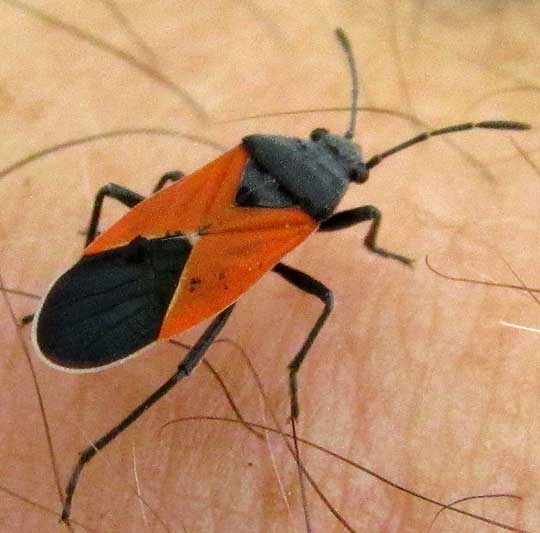Excerpts from Jim Conrad's
Naturalist Newsletter
from the September 21, 2014 Newsletter issued from the Frio Canyon Nature Education Center in the valley of the Dry Frio River in northern Uvalde County, southwestern Texas, on the southern border of the Edwards Plateau; elevation ~1750m (~5750 ft); N29.62°, W99.86°; USA
REDCOAT SEED BUG
Approaching a Prairie False Willow, Baccharis texana, a red and black bug so boldly patterned that it was impossible to overlook was suspended among the bush's white flowering heads. This bug was alert and nervous-acting. Sensing my nearness, he swung his body to behind a flowering head and kept still. Often when you want a bug to move to the front so you can photograph him you can place your hand on the other side of the bug and that'll scare him to move back around, but this one would have none of that and flew onto my arm. Below, you can see him there:

In that picture you can see that I'm not using the term bug sloppily. With mouthparts consisting of a straw-like proboscis used to suck juices from plant parts, plus the thickened bases of the front pair of wings, and the general shape, this is clearly a "real bug" of the True Bug Order, the Hemiptera. According to the Tree of Life Project, nowadays 41 insect orders are recognized (the number varies according to expert), so just knowing that a bug is a "true bug" goes a long way toward identifying who you have.
Volunteer identifier Bea in Ontario quickly pegged our pretty bug as the Redcoat Seed Bug, MELANOPLEURUS BELFRAGEI, distributed throughout Mexico and the hot, arid parts of the southwestern US, from California to Texas.
Nine brightly marked seed bug species, genus Melanopleurus, occur in the US, mainly in the arid Southwest, where normally they feed on members of the Composite Family, exactly as ours was doing. Their favorite parts of the composite plant to feed on are developing buds and seed heads. Seeds that have had their seed coats penetrated by a bug's proboscis may not develop properly or germinate.
The seed bugs' bright coloration, opposite to being camouflage, serves to warn potential predators such as birds and lizards that it's probably bad to eat them. In fact, if you pick up a seed bug you'll be reminded that they're somewhat related to "stink bugs." When both kinds of bugs are bothered they issue a sharp, pungent substance that probably repels predators.